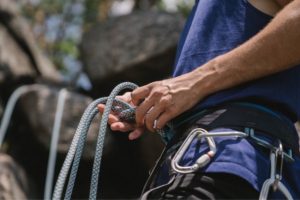Rock climbing can be quite a dangerous activity, and it is advised that beginners and experts alike should take enough precautions.

It is difficult enough that you are battling with so many external conditions and, in most instances, going solo.
In the world of rock climbing, there is a phenomenon called rappelling.
Rappelling is a vital aspect of rock climbing, and at this point, it is worth noting that accidents do happen when climbers do not rappel correctly.
This is due mainly to the failure of their frictional hitches, amongst other reasons.
There are two well-known friction hitch types: the Autoblock and Prusik.
In this article, we will compare them and outline how they have grown to be crucial to rock climbers. So, let’s get started.
First, What Is a Friction Hitch?
Friction hitches are essential for different types of rock-climbing situations. This is also with their critical in serving as an efficient safety backup.
Then also a means to escape the belay and, finally, a tool for promptly ascending the climbing rope in the case of an emergency.
Friction hitches are the core components of every climber’s skillset.
Every climber should know the differences between the different types of hitches; hence the need for this complete comparison between the autoblock and prusik frictional hitches.
Frictional hitches are essential because they can serve as a dependable backup and easily catch you in case anything happens.
It is important to note that for any of the two hitches, the accessory cord must be between (5-7) mm in diameter, and it should be ensured that it is tied in a double fisherman’s knot, as that mode works best.
The length of the cord, which should be based on personal preference, should have a standard diameter between 13.5 and to 24inches.
What Is an Autoblock in Climbing?
This can also be called the “French Prusik” and is used explicitly as a backup. Although it is sometimes commonly tagged a knot, it is an effective frictional hitch.
It is also multi-directional, meaning either way, you are good, as it will catch your weight.
One of the first ways to do the autoblock vs prusik comparison is to outline their ease of knotting.
One advantage of the autoblock is that it is straightforward to tie.
It is used as a backup for rappelling, and the hitch is formed on the rope below the belay device and then firmly clipped to the belay loop of your harness.
The Autoblock will slide when unloaded, but the lock will form tightly when the rope is loaded.
However, the Autoblock is not primarily used in ascending ropes due to its downward sliding mechanism and ease of release.

What is the Prusik Frictional Hitch?
This climbing hitch was developed by the famed Austrian mountaineer Karl Prusik (Just in case you are curious).
Well, the trap works by the user simply threading a cord around a rope and then back through itself about 2 or 3 times to provide perfect locking friction that can easily hold weight and is also difficult to release.
The prusik hitch can be used to move both ways and utilizes the least amount of cord to make.
It also comes in handy if the user wants to connect the prusik hitch to the harness without extending it with a sling.
Do you know that there are also different types of prusik hitch?
The Prusik hitch is perfect for both rappelling and rescue situations. It also takes little time to tie, unlike the autoblock. It is an excellent option for rock climbers.
Autoblock vs Prusik – What Is the Difference?
It is common to find climbers to argue about the best type of frictional hitches whenever they go climbing.
Many claim they love the autoblock because of its versatility and the fact that it can easily be knotted.
The ease of tying is also why some climbers have picked the autoblock over the prusik.
A substantial difference between the autoblock and the prusik is that although they both move multi-directionally, the ease of usage and the time for setting up is quite different for both the autoblock and the prusik.
By design, the prusik frictional hitch best functions when the climber is trying to escape the system.
This is especially when the climber does not want the hitch to release under the load and does not want to move it along the rope for a long
As for the autoblock hitch, if it is adequately fastened, it can be quite an effective frictional hitch to have in case you are trying to scale up in no time.
It can be used to move multi-directionally while offering the user a way to control movement effectively.
Pros and Cons of the Autoblock and Prusik Frictional Hitches
Trying to figure out these frictional hitches can be pretty challenging at first.
Especially with the baseline, you thought its efficiency could be the difference to saving your life.

It is just ideal to fully incorporate the use of a frictional hitch into your practice. Some of the pros and cons of the use of frictional hitches are:
Pros of Autoblock Hitch
- There are no arguments about this; the autoblock keeps you safer: One battle with many external factors when outdoors. It is best that you have a hitch system that you can trust. One that can mitigate any form of risk you can be open to.
It is ideal for getting a frictional hitch that can hold your weight and catch your fall, or just in case you hit your head or get distracted (You never can tell).
- It allows you to control your rappelling movements: In anything you do as a solo rock climber, you should always try to control the situations around you. In this context, we mean from your gear to your backpack, to your climbing rope and ultimately to the type of hitch you decide to go for.
The autoblock, in most instances, is used as a backup for rappelling.
The autoblock is mainly formed on the rope strands below the belay device and clipped to the harness’s leg or belay loop.
- If the autoblock hitch is firm enough, you do not have to worry about loose ends. It helps minimize impact in random accidents. We know anything can happen when you are up there. Losing concentration for a few seconds can be dangerous, and mindless accidents like that are uncontrollable. But a sound hitch system solves this for you.
Cons of the Autoblock Frictional Hitch
- The major disadvantage surrounding using the autoblock hitch is that it can sometimes take much time to fix. In many situations, when going rock climbing or any energy-intensive outdoor activity, remember to keep this in mind.
Pros of the Prusik Frictional Hitch
- It is multidirectional: It appears simple yet is very strong and offers its user much more holding power than the autoblock.
- This also adds to its much-needed versatility, especially regarding its functionality. This multidirectional function means that the rope can get tightened irrespective of the direction of the pull.
- It is a valuable tool for hands-free endeavors: You might need to adjust a part of your gear, or you might want to clean or rappel down while overhanging or even across traverses. The Prusik frictional hitch allows for that.
Cons of the Prusik Frictional Hitch
- The Prusik hitch takes longer to tie: By this, we mean that the only con of using frictional hitches is that the climber takes extra time to secure them into strong knots and fasten them properly to form a strong hitch.
- They are ineffective when frozen wet ropes are involved: You may want to be careful with the prusik hitch because it becomes super inefficient when frozen. This is because they require friction for them to function effectively.
Wrapping Things Up
The essence of comparing Autoblock and Prusik is to highlight the importance of these hitches to climbers and how they can be the significant difference between life and death.
They can also be helpful in many situations, but it is essential to practice the knots to know what works perfectly for you, your frame and your body weight.
We cannot but hope you have a pleasant outdoor time, and we hope your hitches stay strong and you enjoy all the bliss and rush climbing provides so that we will see you again.

I was working as a mountain guide, probably all around the planet. One day, I met my wife in the mountains, literally on top of the world. Now, I have a beautiful family and three kids, so I don’t have much time for climbing, but sometimes I go camping with my friends. I am also into gym workouts, and I can’t imagine my life without sports.
Since I ended my professional career as a climbing guide, I’ve been giving personal classes and helping amateurs to get ready for conquering their first peaks. Also, that’s how the whole blog idea appeared.





